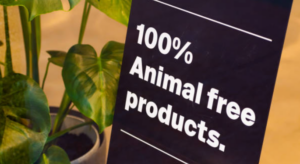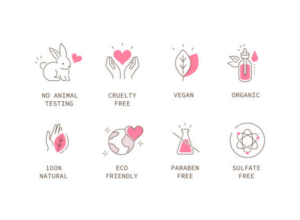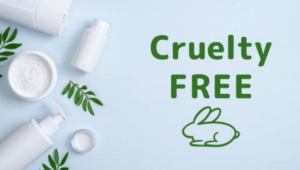Small Steps, Big Impact

In today’s fast-paced world, where choices seem limitless and consumer power is ever-growing, the beauty industry stands at a crossroads. The demand for ethical and cruelty-free products has never been higher, and as conscious consumers, our choices hold immense potential to create a positive impact. This blog post delves into the significance of supporting cruelty-free beauty brands and how these small steps can lead to significant waves of change, not only within the industry but also in the lives of countless animals.
In an era marked by increasing awareness of ethical considerations and environmental impact, the beauty industry has experienced a monumental transformation. The rise of cruelty-free beauty isn’t just a fleeting trend; it’s a powerful movement that reflects the changing values and priorities of consumers around the world.
The shift towards cruelty-free beauty isn’t solely driven by a desire for better products. It’s a response to the evolving values of today’s consumers who demand transparency, accountability, and ethical responsibility from the brands they choose to support. Modern consumers are armed with information and are acutely aware of the implications of their choices. This shift in consciousness has led to a growing disdain for outdated practices like animal testing and a demand for products that align with their ethical beliefs.
Empowering Consumer Choices
In an era of information abundance and increased consumer consciousness, our choices as consumers have become powerful tools for change. When it comes to the beauty industry, opting for cruelty-free brands isn’t just a superficial decision; it’s a profound statement that has far-reaching implications for the industry, animals, and the world at large.
Every purchase we make is a reflection of our values and priorities. By choosing cruelty-free beauty products, we send a clear message to the industry that animal welfare matters to us. This collective voice speaks volumes, not only influencing brands’ business strategies but also catalyzing systemic change. The more consumers support cruelty-free brands, the more brands will respond to this demand, ultimately shifting industry norms away from animal testing.
Consumer demand for cruelty-free options disrupts the traditional norms that have perpetuated animal testing for decades. This disruption forces brands to rethink their strategies and adapt to new ethical standards. By opting for products that align with cruelty-free principles, consumers actively challenge the status quo and create a demand for alternative testing methods that respect both animals and human safety.
Consumer choices have a ripple effect that extends beyond individual purchases. The demand for cruelty-free products influences retailers to allocate more shelf space to these brands, prompting competitors to reevaluate their practices. As the demand for cruelty-free beauty products grows, so does the pressure on non-cruelty-free brands to pivot and adopt more ethical approaches. This shift in the market landscape demonstrates the immense influence consumers hold in shaping industry dynamics.

Consumer demand is a driving force behind industry innovation. As more people seek out cruelty-free options, brands are motivated to innovate and find creative solutions that align with ethical values. The pursuit of cruelty-free products necessitates research into alternative testing methods, the exploration of innovative ingredients, and the development of sustainable packaging. In essence, supporting cruelty-free brands encourages the beauty industry to evolve and embrace more ethical, sustainable, and innovative practices.
Cruelty-free brands often prioritize transparency in their operations, openly sharing their testing practices, sourcing methods, and ingredient choices. This level of transparency holds brands accountable for their claims and empowers consumers to make informed choices. By supporting brands that are open about their processes, consumers contribute to an environment where honesty and integrity are valued, encouraging other brands to follow suit.
The cruelty-free movement is fundamentally a grassroots movement fueled by individual choices. When each consumer makes the conscious decision to choose cruelty-free, the collective impact becomes tangible. Social media and online platforms have amplified the power of these choices, allowing individuals to share their experiences and recommendations with a global audience. As this movement gains momentum, its influence extends far beyond personal care routines, inspiring a broader shift in consumer behavior.
Ingredients Innovation and Quality
In the pursuit of cruelty-free beauty, one of the most remarkable outcomes has been the intersection of ethics and innovation, leading to a transformation in ingredient research and product formulation. Contrary to misconceptions, cruelty-free brands are at the forefront of ingredients innovation, pushing the boundaries of quality, safety, and efficacy.
Historically, animal testing was seen as a necessity for ensuring product safety and effectiveness. However, the cruelty-free movement has spurred a wave of innovation that challenges this outdated notion. Brands that commit to cruelty-free practices are compelled to seek alternatives to animal testing, resulting in the exploration of advanced technologies and testing methods.
Cruelty-free brands have been at the forefront of promoting in vitro testing, which involves testing products on cultured human cells rather than animals. This method not only sidesteps the ethical concerns associated with animal testing but also provides more accurate insights into human reactions. In vitro testing allows brands to assess the safety and efficacy of their products more comprehensively, resulting in higher-quality formulations that better cater to human needs.

Another exciting avenue of innovation is the development of 3D tissue models that mimic human skin. These models offer a more accurate representation of how products interact with human skin, providing invaluable data for product development. Furthermore, computer simulations and artificial intelligence tools are being harnessed to predict product responses and interactions, reducing the reliance on animal testing while ensuring consumer safety.
Cruelty-free brands often place a strong emphasis on sourcing natural and sustainable ingredients. In the quest to avoid animal testing, brands have turned to nature’s bounty for inspiration. This shift has led to a renewed focus on botanical extracts, plant-based oils, and eco-friendly alternatives that not only provide superior results but also align with consumer preferences for clean and conscious beauty.
In the past, the pursuit of endless variations and iterations often led to products that were neither effective nor beneficial. Cruelty-free brands, on the other hand, prioritize quality over quantity. With a focus on ingredients that have been thoroughly tested through innovative methods, these brands are more likely to deliver products that truly deliver on their promises, enhancing the consumer experience.
Cruelty-free brands also play a role in educating consumers about the importance of ingredients, empowering them to make informed choices. By prioritizing transparency in their ingredient lists and formulation practices, these brands equip consumers with the knowledge they need to select products that align with their values and cater to their unique skincare needs.
Cruelty-free beauty is inherently linked to ethical considerations and environmental responsibility. Brands that choose to abstain from animal testing often extend this commitment to other facets of their operations, including sustainable sourcing, eco-friendly packaging, and reduced carbon footprints. This holistic approach to beauty aligns with the values of conscious consumers who recognize that true beauty should not come at the expense of the environment or the well-being of other creatures.
The Ripple Effect: Industry Transformation
The beauty industry operates on trends and consumer preferences. As cruelty-free beauty gains momentum, brands are compelled to reevaluate their practices to remain relevant in the market. This ripple effect is leading to an industry-wide transformation where even longstanding players are adopting cruelty-free policies to stay competitive. By supporting cruelty-free brands, consumers actively contribute to this transformation, encouraging more and more companies to join the movement and create a lasting impact.
In the dynamic and ever-evolving landscape of the beauty industry, the cruelty-free movement has given rise to a phenomenon that goes beyond ethical choices—it’s a celebration of individuality, passion, and empowerment. Small-scale cruelty-free beauty brands are emerging as key players in this movement, offering unique perspectives, innovative products, and a personal touch that resonates deeply with consumers.
Small cruelty-free brands often emerge from the passions and values of their founders. These brands are driven by a desire to make a difference in the beauty industry by offering products that align with ethical principles. This passion is palpable in every aspect of their offerings, from carefully curated ingredients to thoughtfully designed packaging. Supporting these brands means supporting individuals who are dedicated to making a positive impact through their creations.

Small cruelty-free brands are known for their ability to cater to niche markets and unique needs. While larger brands may follow trends, small brands have the flexibility to focus on specific concerns, skin types, or preferences. This diversity translates to a wide array of products that cater to various skin tones, hair types, and individual preferences, providing consumers with choices that resonate with their distinct identities.
The shift towards cruelty-free beauty isn’t solely driven by consumer choices—it’s also fueled by advocacy and education. Many cruelty-free brands actively engage in outreach programs to raise awareness about animal testing and the benefits of cruelty-free products. By supporting these brands, consumers indirectly participate in spreading knowledge and influencing others to make ethical choices. This collective effort serves as a catalyst for larger conversations about the ethics of beauty and the power of conscious consumerism.
In a world that often feels overwhelmed by challenges, supporting cruelty-free beauty brands offers a tangible way to create lasting change. Every purchase is a step towards dismantling outdated norms and encouraging a more compassionate approach to beauty. As more individuals embrace this ideology, the demand for cruelty-free products will continue to rise, making it increasingly difficult for brands to ignore the call for change.
Small steps, when taken collectively, can lead to waves of change. The cruelty-free beauty movement exemplifies this concept beautifully. By supporting brands that prioritize compassion, ethics, and innovation, we actively contribute to an industry that is evolving towards a more sustainable and humane future. The power lies in our hands as consumers to shape an industry that reflects our values and paves the way for a world where beauty is not just skin deep but extends to the well-being of all living beings. So, let’s take those small steps, for they have the potential to create an impact that resonates far beyond the realm of beauty.




